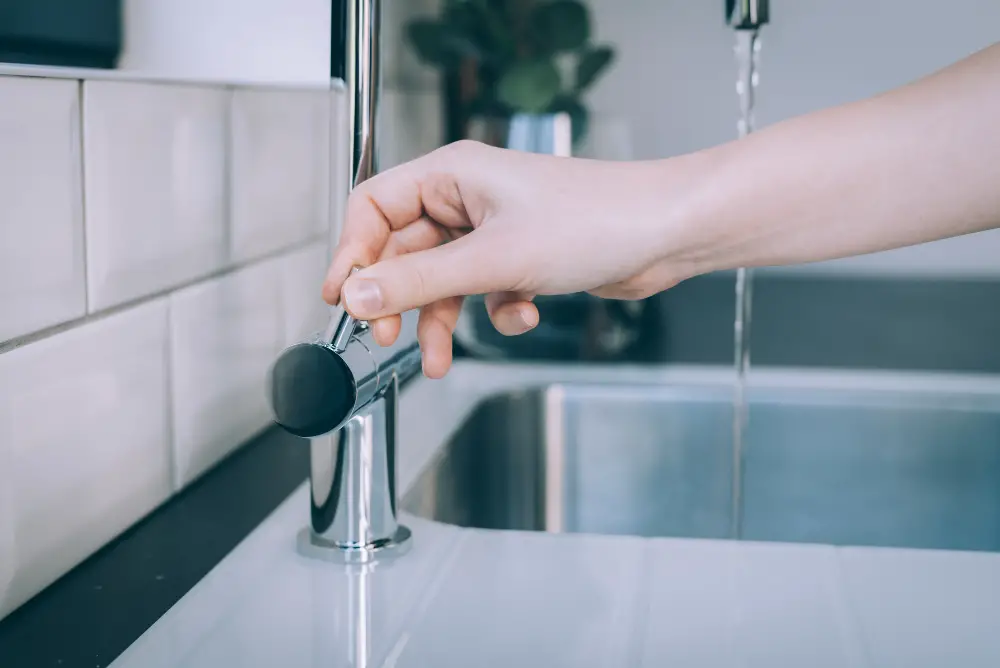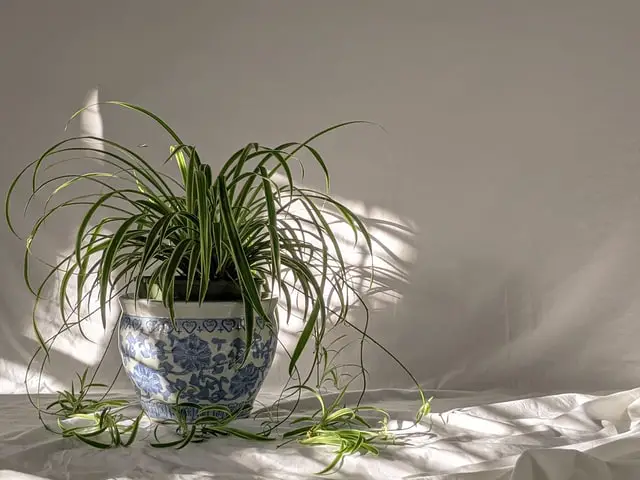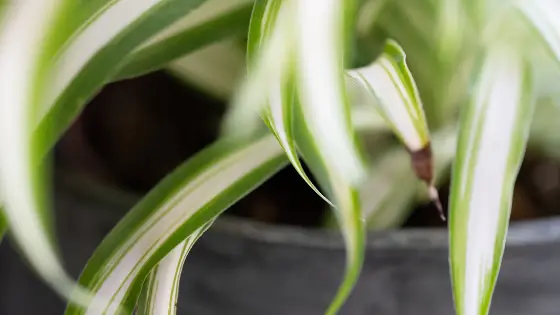You’re thinking of cutting off the dead tips of your Spider plant. So you’re asking yourself: Should I cut off the dead tips of my spider plant? And so are we, in this article.
Table of Contents
Should I Cut The Dead Tips Off My Spider Plant?
Cutting off the dead tips of your spider plant will not cause any harm to the plant. Cut them at an angle to preserve the leaf’s form, or remove the afflicted leaves from the plant totally. For the prevention of bacterial and fungal diseases, check that your pruners are clean and sharp before using them.
Spider plants can have dead tips as a result of a wide variety of conditions, including overexposure to sunshine, fertilizer burn, excessive fluoride content, poor humidity, and water problems.
Dead Tips hardly offer a serious harm to the health of your plant, so you don’t need to be concerned.
It’s up to you whether or not to remove the spider plant’s Dead Tips if you feel they distract from the overall appearance of the plant.
Read more: Why is my Spider Plant drooping?
Why Does My Spider Plant Have Dead Tips?

If you have a spider plant and you see what appear to be dead tips on the plant, it is likely due to one or more of the following factors:
Water Stress
Dead tips on spider plants are frequently the consequence of water stress. The two extremes of water stress are known as underwatering and overwatering, respectively.
Unfortunately, the symptoms of an overwatered spider plant and an underwater spider plant are essentially identical, save from a few small changes.
Dead tips on overwatered spider plants are caused by root rot and oxygen shortage. Since nutrients and water cannot reach the tips of the leaves, the tips of the leaves will become brown.
Underwatering, on the other hand, limits the quantity of rainwater and nutrients that the soil can absorb. As a direct consequence of this, the undersides and apexes of the leaves will become brown and crispy.
Sunburned and wilted spider plants are common after being immersed for a lengthy period of time. The soil is nearly always light gray and bone dry, and the pot is generally lighter than usual.
In either scenario, the leaves may get yellow and fall off as a result of the lack of water.
Read more: Why Are My Spider Plant Leaves Folding?
How to Revive a Spider Plant with Dead Tips and Water Stress
To get started, you have to take off the dead tips and any leaves that are a yellowy color than normal. The leaves will not turn green even if your plant recovers from the stress.
If the spider plant is underwater, it must be placed in a tub or sink filled with water. It will keep absorbing water until the soil is totally saturated. Before replacing the saucer, drain any excess water from the drainage holes.
There is no fast remedy for dead tips caused by overwatering. First, examine the roots to see if there are any symptoms of rot.
If deterioration is apparent, cutting out rotten and dead roots can promote recuperation and prevent their reappearance. Healthy roots can be treated with hydrogen peroxide or cinnamon.
At this point, you can either repot your plant into a fresh batch of growing medium or allow it to dry out completely before doing so.
Read more: Why Are My Spider Plants Leaves Curling?
Chlorine and fluoride levels in city water are high.

Because spider plants are prone to damage from fluoride and chlorine, it is critical to ensure that they are kept away from this type of water at all times. Unfortunately, tap water is to blame for the majority of spider plant brown tip occurrences, which may surprise you.
In order to eliminate microorganisms and forestall tooth decay, the majority of municipalities in the United States treat their city water with chlorine and fluoride. Sadly, these toxins can collect in the soil and cause damage to your spider plant by burning the roots of the plant as they grow.
Furthermore, fluoride is highly phototoxic, which means it destroys leaf tissue and slows photosynthesis.
Reddish-Dead Tips on the leaf edges are often an indication of fluoride toxicity, whereas tarnish-gray tips may be the result of excessive amounts of boron in the soil.
How to Revive a Spider Plant with Excess Fluoride and Chlorine
If your spider plant has dead tips because of high levels of fluoride and chlorine, there are a few things you can do to fix the problem and keep it from occurring again.
To begin, these chemicals need to be washed off by first being thoroughly watered with water that has been distilled or filtered. After that, continue the flushing process as many times as necessary until the levels of chlorine and fluoride have dropped noticeably.
Use a calcium-rich potting medium to offset any fluorides.
Avoid the accumulation of these pollutants by using distilled or bottled water. You can utilize rainwater or install a water filtering system.
Read more: Should I Cut Bent Spider Plant Leaves?
Inadequate Humidity
Spider plants flourish in humid settings. However, when there is a lack of humidity, the tips of the leaves will brown and dry off.
While spider ivy is considered a good houseplant, it is usually unhappy during the winter when humidity levels in the house drop due to electric heating running.
How to Fix This Issue
Keeping your spider plant in a humid atmosphere over the winter is the best approach to guarantee proper humidity levels and keep it happy. The restroom or the kitchen are both good choices.
Mist your plant every few hours using a humidifier, a pebble-filled water tray, or a hose.
By grouping your houseplants, you may also create a humid microclimate for your spider plant.
Excessive Sun Exposure

Spider plants grow in shaded or sunny, indirect light. Despite their toughness, these plants will become burnt or sunburned if left in full sunlight for a lengthy period of time.
As a consequence of this, your Chlorophytum comosum will develop Dead Tips if it is subjected to an excessive amount of direct sunlight. In addition to this, sunburn can cause brown patches to form on the surface of the plant’s leaf.
Read more: Why Is My Spider Plant Pale And Limp?
How to Fix This Issue
Sunburns are most frequent in early spring, when the days are longer and the light is brighter. To avoid this problem, either bring your outdoor potted spider plants indoors or at the very least give them some shade where they are located.
If you intend to keep your plant inside, you should make sure it receives light that ranges from mild to bright but is indirect. Usually, the issue might be resolved by relocating the pot a few feet away from a south-facing window.
Fungal Diseases
In spite of the fact that spider plants rarely cause problems, these plants are prone to fungal infections. This condition might be caused by an insect infestation, overwatering, or nutritional inadequacies.
Dead Tips are often caused by one or both of the following fungal diseases: leaf spots, root rot, or both. Fungal diseases are at their most active during the cold winter months, which is also when they cause the most harm to leaves.
The undersides of the leaves and the leaf edges are the first places to show signs of the brown lesions. After that, big brown patches will begin to appear as they continue to grow and eventually combine with one another.
As a result, the afflicted leaves will gradually turn brown or black and fall off the plant. Dead Tips are frequently caused by disease damage to the leaf tips.
Read more: Why Are My Spider Plant Leaves Creasing?
Treatment Options
- Always be sure to follow proper sanitation procedures when gardening, such as:
- Avoid contact with the leaves if your hands are dirty or moist.
- Maintaining the cleanliness and sterility of cutting equipment both before and after usage.
- Leaving a sufficient distance between each of your houseplants
- removing and disposing of any dead plant materials and debris
- Avoid soaking or splashing the foliage.
Use a fungicide that is based on copper or sulfur as an alternate method of treatment if you want to get rid of your spider plant via chemical means. Applying a fungicide that is low in toxicity at the beginning of the summer can help prevent further outbreaks.
Excessive Fertilizer Salts in the Soil
Fertilizer salts and other pollutants, such as those that might be present in municipal tap water, can be harmful to spider plants. The accumulation of salt in the soil, which is hazardous to your plant and typically manifests itself as “dead tips” on the leaves, can be caused by an increased feeding of fertilizer.
Excess fertilizer salts in the soil can also cause root damage. As a direct consequence of this, your plant will have a diminished capacity to take in nutrients and water. The leaves will dry out and become brown at the tips due to a lack of nutrition.
How to Fix an Overfertilized Spider Plant
Your first order of business should be to discontinue the use of fertilizer.
The following step is to saturate the soil until it drains through the drainage holes. By carrying out this process many times, any excess salts that the fertilizer may have left behind may be removed.
You have the option of using a brand-new potting mix that has enough drainage when you repot your spider plant.
Read more: How Do You Bring A Spider Plant Back To Life?
Why Should You Cut Off Dying Spider Plant Leaves?
By removing any leaves that are dead or decaying from your spider plant with pruning shears, you may encourage the growth of new foliage that is robust and healthy. Brown leaves, after all, aren’t likely to spring back to life or become green very soon.
Your spider plant will not benefit in any way from these wilting leaves because it is highly improbable that they will function, hold moisture, or photosynthesize.
Furthermore, wounds on these leaves might store pathogens or serve as entrance sites for bacterial and fungal diseases, exacerbating the issue.
Getting rid of them is clearly the best option.
How to Trim Dead Spider Plant Leaf Tips?
It’s less than pleasing when the tips of your spider plant’s leaves turn yellow. You’ll be relieved to know that the dead tips may be pruned away without causing any harm to the plant.
Use a sterilized knife, scissors, or pruners with sharp, well-maintained blades to cut them off. Cut at an angle to maintain the pointed form of the foliage you are trimming.
If you want to avoid the transfer of infections from one leaf to the next, you should clean the pruning tool with isopropyl alcohol after each cut you make.
Conclusion
Should I Cut The Dead Tips Off My Spider Plant?
You are not required to cut off the dead tips, although you may do so if you so like. Dead tips, by themselves, do not cause any damage or injury to the plant.
They are just dead plant tissue that dries, sometimes turns papery to the touch, and falls off upon contact.
This is due to an underlying problem that may be addressed, but the old leaves will not heal themselves.
Shrug photo created by wayhomestudio – www.freepik.com
Sink photo created by wirestock – www.freepik.com
Photo by Susan Wilkinson on Unsplash



